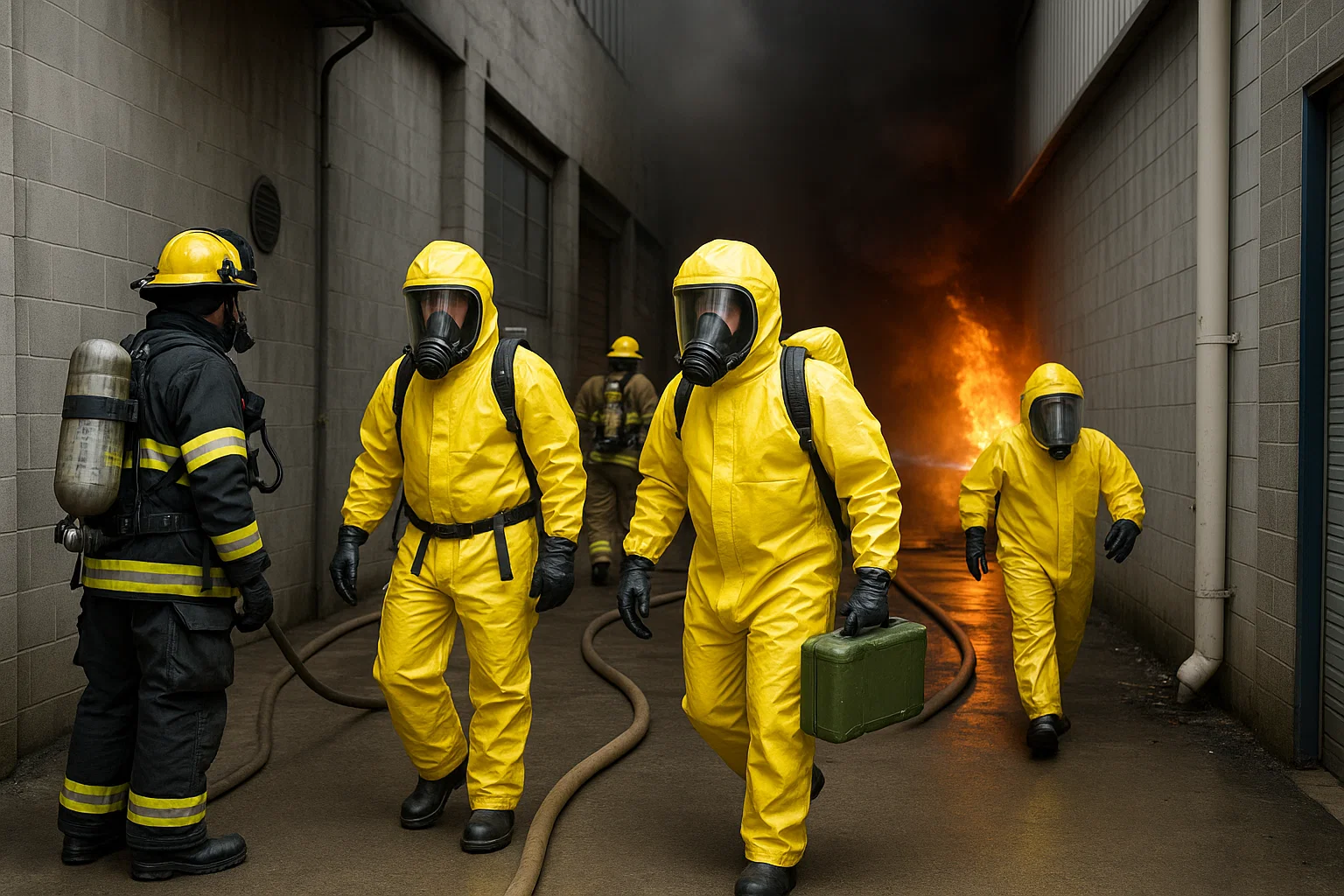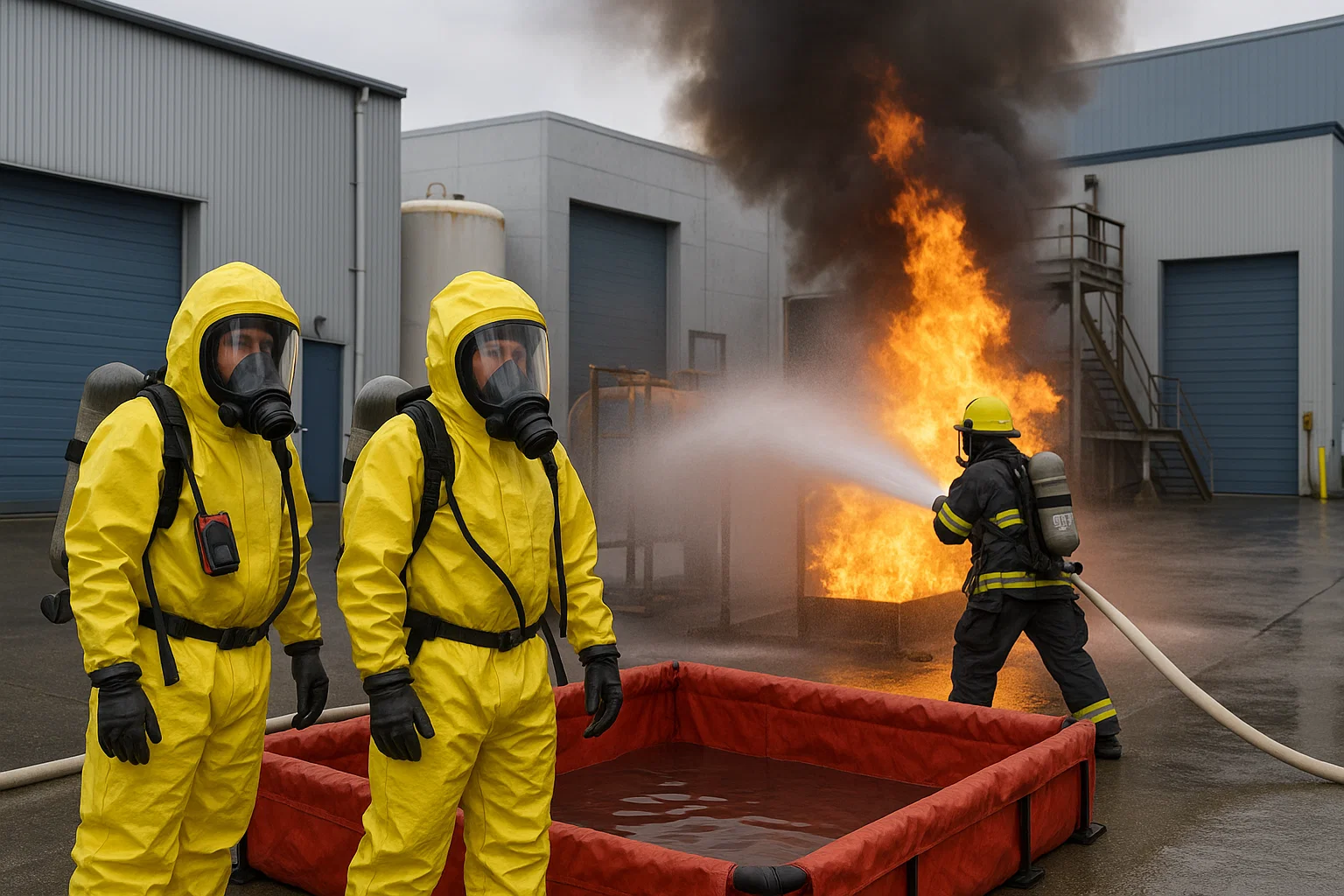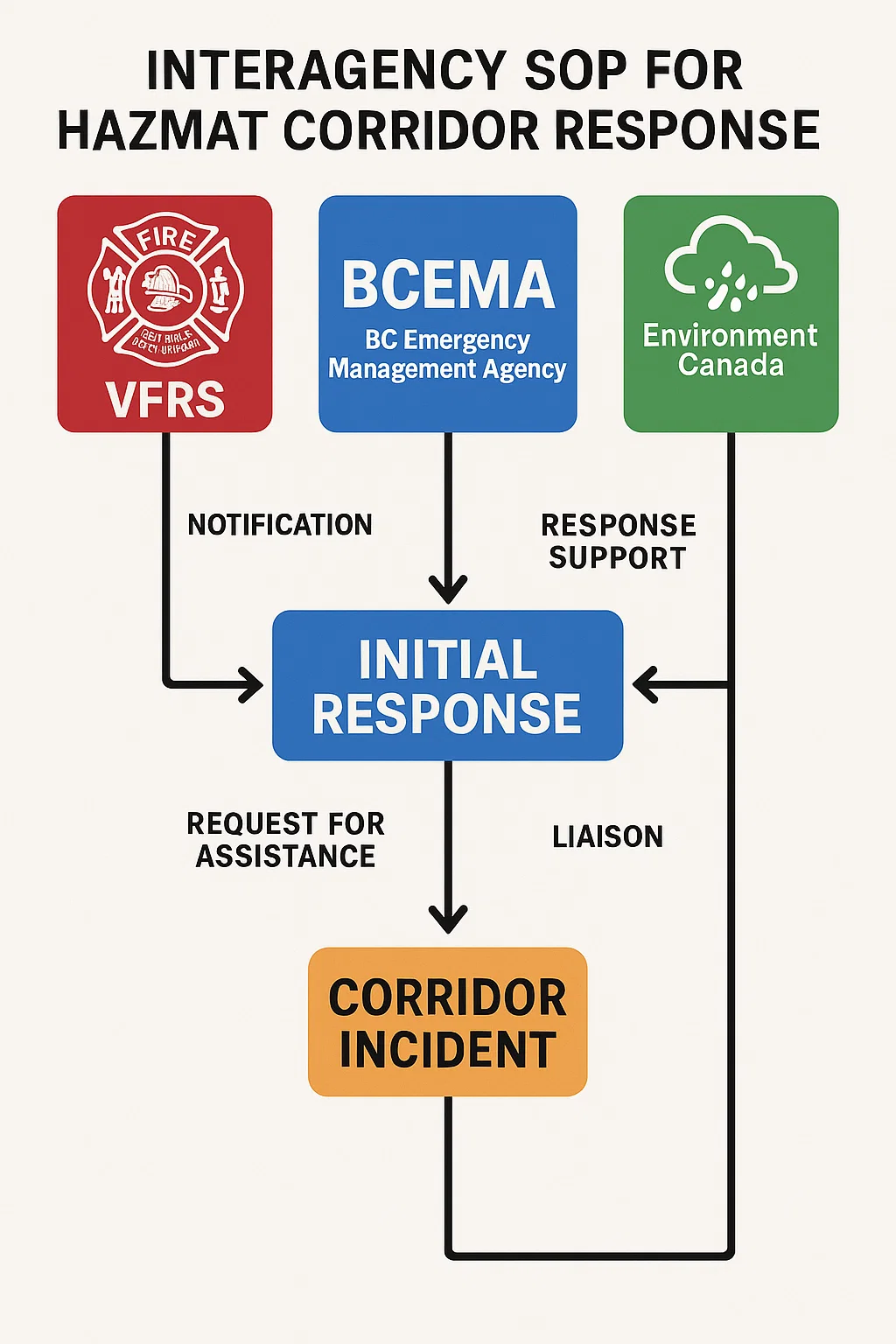
To protect the public and responders, Vancouver Fire Rescue Services (VFRS), BC Emergency Management Agency (BCEMA), and Environment Canada have developed a synchronized framework built on NFPA 472, NFPA 1500, and CAN/CSA Z731. These standards reinforce not only tactical field response but also command-level coordination across city, regional, and federal agencies.
This guide provides a professional-level briefing on the hazards, tools, command models, and interagency SOPs essential for mitigating industrial fire and HazMat incidents in Vancouver’s urban-industrial corridors.
Understanding Vancouver’s HazMat Corridor Risk Profile
The Vancouver region’s industrial zones include marine terminals, railways, energy plants, and warehouse complexes storing volatile chemicals such as ammonium nitrate, chlorine, propane, and hydrocarbon derivatives. HazMat corridors here function as critical transportation routes for these materials, creating elevated risk nodes where fires can escalate rapidly into toxic or explosive events.
Primary Hazard Zones
- Port of Vancouver Fuel Terminals: Large-volume flammable liquid tanks with limited separation distances.
- False Creek and Rail Yards: Frequent transfer of pressurized cylinders and corrosive materials.
- Fraser River Industrial Belt: Aging pipelines and storage tanks within proximity to residential areas.
- Downtown Underground Utilities: Potential for vapor migration and confined-space ignition.
Incident Trends (2023–2025)
Recent VFRS incident data indicate that nearly 17% of all industrial fire calls involved some form of hazardous-material involvement, either as a primary hazard or secondary release. Most incidents required partial evacuation and multi-agency coordination exceeding the single-jurisdiction command span.
Operational Lesson
Interagency lag remains a key vulnerability. Initial command transfer between VFRS and Environment Canada often takes longer than 20 minutes when plume modeling data is delayed a gap that can significantly influence downwind exposure.
Tactical Foundation: NFPA-Based HazMat Response Integration
At the operational level, Vancouver follows NFPA 472 (Competence of Responders to Hazardous Materials Incidents) as the tactical baseline. All HazMat team members complete annual refreshers focusing on identification, control, and decontamination procedures.
| Tactical Framework | Key Objective | Local Application |
|---|---|---|
| NFPA 472 | Competency and task performance standards for HazMat teams | Mandated by VFRS HazMat Team certification |
| NFPA 1500 | Fire Department Occupational Safety & Health Program | Sets PPE, rehab, and decon safety protocols |
| NFPA 1962 | Inspection, Care, and Use of Hose Systems | Ensures proper hose line use for industrial foam systems |
| CAN/CSA Z731 | Emergency Preparedness and Response | Framework for multi-agency incident action planning |
| OSHA 29 CFR 1910.120 | Hazardous Waste Operations & Emergency Response (HAZWOPER) | Adopted in part for cross-border industrial coordination |
These frameworks shape how Vancouver’s agencies train and execute particularly in confined industrial corridors where flammable vapors and topographic containment elevate risk levels.
Incident Command and Communication Systems
The cornerstone of a successful HazMat corridor response is a Unified Command System (UCS), structured under ICS Canada and integrated with local emergency management policies. In Vancouver, command typically establishes as follows:
- Incident Commander (IC): Senior VFRS officer responsible for scene control and tactical oversight.
- Safety Officer: Monitors air readings, PPE compliance, and exclusion zone boundaries.
- HazMat Branch Director: Coordinates entry, identification, and containment teams.
- Agency Liaison: Communicates between VFRS, BCEMA, Transport Canada, and municipal utilities.
Interagency Coordination in Action
When a corridor incident escalates, the BC Emergency Management Agency (BCEMA) assumes coordination authority under the Emergency Program Act. This involves integrating municipal and provincial resources, issuing public alerts, and ensuring compliance with environmental response statutes.
Environment Canada contributes atmospheric modeling through CANERM (Canadian Emergency Response Model), providing data on chemical dispersion to guide evacuation perimeters and resource allocation.
Pro Tip: Unified Radio Channels Save Lives
Always predefine radio talk groups before corridor operations. Switching mid-incident can fragment situational awareness and delay rescue. Vancouver agencies standardize on 800 MHz trunked systems linked through the E-Comm network practice radio discipline and confirm interoperability before entry.

Hazard Assessment and Entry Protocols
Responders in corridor incidents must adopt defensive and containment tactics first, prioritizing atmospheric monitoring and exposure control before any suppression. The decision matrix used by VFRS HazMat technicians follows a standardized three-phase sequence:
Phase 1: Scene Assessment
- Conduct 360° recon from a safe standoff distance using thermal imagers and gas detection (PID, FID, and 4-gas meters).
- Establish Hot, Warm, and Cold Zones per NFPA 472 Annex C.
- Identify UN placards, container types, and possible ignition sources.
Phase 2: Control & Containment
- Apply remote valve shutoff and foam blankets when safe to access.
- Deploy portable dikes or absorbent booms to prevent runoff.
- Utilize Class B foams with low environmental persistence (per Environment Canada Directive 2024).
Phase 3: Decontamination & Recovery
- Set up gross decon lines within the Warm Zone using high-pressure low-volume spray systems.
- Ensure PPE decon with pH-neutral agents.
- Post-incident documentation aligns with NFPA 1500’s health monitoring clause for responder exposure.
Pro Tip: Time Equals Exposure
Every minute in a hot zone multiplies absorption risk. Vancouver’s current SOP limits initial technician exposure to 20 minutes per cycle, followed by a mandatory 15-minute rehab monitored by medical support teams.
Industrial Fire Dynamics and Tactical Suppression
Industrial fires along HazMat corridors are rarely isolated to a single fuel source. Response teams often face a hybrid event: a liquid hydrocarbon fire adjacent to compressed-gas cylinders, electrical transformers, or solvent storage tanks.
Suppression Tactics
- Foam Application: NFPA 11 recommends a minimum application rate of 0.16 gpm/ft² for hydrocarbon fuels. Vancouver uses protein-based foams compliant with environmental guidelines.
- Water Supply: Pre-plan hydrant spacing along corridors (150 m intervals) to maintain flow rates above 3,000 L/min.
- Thermal Imaging: Deploy TICs for hot-spot mapping within containment areas.
- Ventilation Control: Close adjacent industrial dampers and use positive pressure fans at decon exits.
Tactical Decision Points
- Use defensive tactics until product identification is confirmed.
- Avoid applying water streams directly onto reactive metals or electrical installations.
- Prioritize exposure protection over extinguishment in high-heat plume events.
Responder PPE and Decontamination Standards
Proper PPE choice determines responder survivability and contamination control. Vancouver’s HazMat teams utilize Level A or B suits depending on product volatility.
| PPE Level | Protection Type | Use Case |
|---|---|---|
| Level A | Fully encapsulated with SCBA | Unknown vapors, chlorine gas, or ammonia leaks |
| Level B | Splash protection with SCBA | Flammable liquid spill, confined corridor vapor exposure |
| Level C | Air-purifying respirators (APR) | Low-concentration vapor drift |
| Level D | Basic turnout gear | Post-decon overhaul, no vapor presence |
Decon Flow Design (NFPA 472, Section 8.3):
- Primary decon line (gross rinse)
- Secondary station (scrub and rinse)
- Final station (suit doffing and monitoring)
Decon runoff is collected per Environmental Management Act (BC) and transferred to certified hazardous waste facilities.
Transport and Corridor Control Measures
Industrial corridors in Vancouver include shared public infrastructure railways, marine docks, and highways. Containment efforts often require rapid access restriction and public evacuation.
Traffic Isolation Measures
- Utilize BC Ministry of Transportation protocols for dynamic lane closure.
- Deploy automated barriers where available (Port Metro corridors).
- Assign traffic control points (TCPs) beyond 500 m downwind of hot zone.
Evacuation Coordination
Evacuation decisions rely on CANERM plume models combined with local meteorological data. In densely populated zones, alerts are issued via Alert Ready and the Vancouver Emergency Notification System (VENS).
Checklist: Corridor Incident Quick Reference
| Action | Responsible Unit | Standard / Reference |
|---|---|---|
| Identify material and scene hazards | HazMat Branch | NFPA 472 §4.3 |
| Establish Hot/Warm/Cold zones | Safety Officer | NFPA 472 Annex C |
| Notify interagency partners | Command | BCEMA SOP 2025 |
| Control traffic and evacuate | Police Liaison | VENS / CANERM |
| Begin decon and medical monitoring | EMS / HazMat | NFPA 1500 §8.9 |
| Complete incident documentation | Planning Section | CSA Z731 §5.6 |
Fire Investigation and Post-Incident Review
Following containment and suppression, the investigation phase begins under the joint authority of VFRS Fire Investigations and Environment Canada Enforcement. All evidence collection follows NFPA 921 methodology, ensuring legal defensibility and insurance transparency.
Key post-incident tasks include:
- Vapor and residue sampling (chain of custody maintained).
- Drone-based thermal survey for hidden combustion.
- Environmental testing for groundwater and soil contamination.
- Responder exposure reports filed under VFRS Health & Safety Division.
Post-incident debriefs are conducted within 72 hours using the After Action Review (AAR) model focusing on lessons learned, communication flow, and cross-agency interoperability.
Interagency SOP Development and Training
Continuous improvement of corridor safety depends on joint exercises. Vancouver runs semiannual multi-agency drills involving:
- VFRS
- BCEMA
- Vancouver Police Department (VPD)
- Port Authority
- Transport Canada
- Environment Canada
These exercises test command transition, plume tracking, and shelter-in-place messaging.
The training framework aligns with CSA Z731 Clause 5.3, requiring evaluation, documentation, and revision of response plans every two years.

Integrated Command Workshops
In 2024, Vancouver’s Port Authority and VFRS conducted “Operation Harbor Shield” a large-scale simulation combining marine fuel fire and chlorine leak scenarios. The exercise validated interoperable communications and public warning timing, achieving full message distribution within 7 minutes of notification a benchmark for future corridor drills.
Public Communication and Community Safety
Community trust depends on transparent, timely information. During corridor incidents, Joint Information Centers (JICs) coordinate updates to prevent misinformation and panic.
Public alerts follow a three-tier message model:
- Initial Warning: Chemical release detected, avoid area.
- Update Message: Response in progress, possible evacuations.
- All-Clear: Containment achieved, safe to return.
BCEMA recommends public education campaigns emphasizing evacuation readiness and in-home sheltering practices, including HVAC shutoff and door sealing.
Pro Tip: Visual Data Wins Trust
Incorporate real-time plume maps and safety perimeters into all media briefings. Public confidence increases significantly when warnings include visual confirmation from trusted sources.
Emerging Tools and Technologies
As of 2025, Vancouver has adopted several advanced technologies to enhance corridor safety:
- AI-driven plume modeling: Predictive dispersion algorithms reduce evacuation uncertainty.
- Thermal drone reconnaissance: Provides early heat detection over rail and pipeline routes.
- Portable FTIR analyzers: On-site identification of unknown gases within seconds.
- Cloud-based command dashboards: Synchronize agency data and unit locations in real-time.
These tools integrate with VFRS’s Incident Management Dashboard, ensuring precise hazard visualization and accountability across units.
Maintaining Operational Readiness
Sustained corridor readiness requires continuous policy updates and training evaluation.
VFRS mandates:
- Quarterly HazMat technician recertification under NFPA 472.
- Annual joint tabletop exercises with BCEMA and Environment Canada.
- Review of every corridor’s pre-incident plan to ensure GIS mapping accuracy.
- Equipment audits for foam systems, detection meters, and PPE integrity.
Key Takeaways for Field Commanders
- Interagency Communication is Non-Negotiable. Every second counts in cross-jurisdictional handoffs.
- Scene Safety Precedes Suppression. HazMat containment comes before extinguishment.
- NFPA Standards are Living Tools. Apply updates regularly, especially in mixed industrial zones.
- Post-Incident Documentation Ensures Accountability. Reports build institutional memory and funding justification.
FAQ Section
Q1: What are the most common hazardous materials transported through Vancouver’s industrial corridors?
A: Primary materials include propane, ammonia, ethanol, petroleum distillates, and chlorine derivatives. Each requires unique containment and firefighting methods per NFPA 472 protocols.
Q2: How often does Vancouver Fire Rescue conduct HazMat corridor drills?
A: Twice yearly one tabletop and one full-scale field drill in coordination with BCEMA and Environment Canada.
Q3: What foam agents are approved for use in Vancouver industrial fires?
A: Protein-based and fluorine-free foams meeting Environment Canada’s 2024 directive, reducing persistent organic pollutants.
Q4: Who leads interagency coordination during a large-scale HazMat event?
A: BCEMA takes coordination authority once the event exceeds municipal capacity, under the Emergency Program Act.
Q5: How are decontamination runoff and waste managed?
A: Collected under NFPA 472 Section 8.3 and transferred to certified waste facilities per the Environmental Management Act.

Emma Lee, an expert in fire safety with years of firefighting and Rescuer experience, writes to educate on arescuer.com, sharing life-saving tips and insights.
